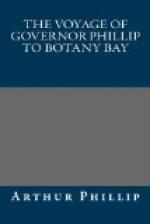10 June 1787
By the 10th of June the ships had completed their water, and early the next morning, the Governor gave the signal for weighing anchor, and the fleet pursued its course.
Report of the marines and convicts under medical treatment, given in to Governor Phillip, June 4th, 1787.
Charlotte, — Marines 4 Convicts 16
Alexander, — Marines 2 Convicts 26
Scarborough, — Marine 1 Convicts 9
Friendship, — Convicts 13
Lady Penrhyn, Convicts 11
Prince of Wales, Marines 2 Convicts 7
—–
Total
Marines 9
Convicts
72
Convicts dead since the first embarkation 21
Children of convicts 3
Of these only fifteen, and one child, had died since
the departure from
Spithead.
Chapter IV.
June 1787 to September 1787
Attempt to put in at Port Praya—Relinquished—Weather—Sail for Rio de Faneiro—Reasons for touching at a South American port—The Fleet passes the Line—Arrives at Rio de Faneiro—Account of that Place—Transactions there—Departure.
Vegetables not having been so plentiful at Santa Cruz as to afford a sufficient supply, it was the intention of Governor Phillip to anchor for about twenty-four hours in the Bay of Port Praya. The islands on this side of the Atlantic, seem as if expressly placed to facilitate the navigation to and from the Cape of Good Hope: by offering to vessels, without any material variation from their course, admirable stations for supply and refreshment. About latitude 40, north, the Azores; in 33, the Madeiras; between 29 and 27, the Canaries; and between 18 and 16, the Islands of Cape Verd, successively offer themselves to the voyager, affording abundantly every species of accommodation his circumstances can require. On the Southern side of the Equator, a good harbour and abundance of turtles give some consequence even to the little barren island of Ascension; and St. Helena, by the industry of the English settlers, has become the seat of plenty and of elegance. Without the assistance derived, in going or returning, from some of these places, the interval of near forty degrees on each side of the line, in a sea exposed to violent heat, and subject to tedious calms, would be sufficient to discourage even the navigators of the eighteenth century.
18 June 1787
On the 18th of June, the fleet came in sight of the Cape Verd Islands, and was directed by signal to steer for St. Jago. But the want of favourable wind, and the opposition of a strong current making it probable that all the ships would not be able to get into the Bay, the Governor thought it best to change his plan. The signal for anchoring was hauled down, and the ships were directed to continue their first course;




